Vietnam has been deeply influenced by the cultural ideas of China due to its thousand years of domination by this country. When China was under the reign of Vo Tac Thien, which dynasty did Vietnam belong to and what was the situation of our country at that time?
When Vo Tac Thien ascended to the throne, ruling China, what was the situation of our country?
In 684, Vo Tac Thien abolished Ly Hien (Duong Trung Tong) and established Du Vuong Ly Dan as the king (Duong Due Tong). But 6 years later, Vo Chieu also abolished this son of his and proclaimed himself emperor, establishing the Vo Chu dynasty. She moved the capital back to Dong Do (Lac Duong), renamed it Thanh Do, but the capital under the law is still Truong An.
This period in Vietnam is the third period of northern domination. According to historians, the third period of northern domination in Vietnamese history lasted from 602 – 905 (or 939). The beginning of this period was when Tuy Van De sent Liu Feng to invade Van Xuan, and King Ly Phat Tu surrendered because of fear of the enemy. He was captured and exiled to China. Northern Vietnam at that time was classified as a province of the Tuy family, called Chau Giao.

In 618, the Tang Dynasty overthrew the Tuy family and established the Great Tang Dynasty. Kau Hoa at that time was the general who requested submission in 622, and Vietnam became a vassal of the Great Tang Dynasty. This third period of northern domination lasted for over 300 years.
In 679, the Tang Dynasty changed Giao Chi province back to Chau Giao, establishing the protective capital of Giao Chau. At this time, Linh Nam had 5 protective capitals, managing Chau Giao, Chau Quang, Chau Que, Chau Dung, Chau Ung, collectively called Linh Nam five management.
Later on, the Tang Dynasty changed the protective capital of Giao Chau to An Nam protective capital. This also marked the name of An Nam in Vietnamese history. The official in charge of the An Nam Protective Capital at that time was called Kinh Luoc Su, later changed to Tiet Do Su.
The Tang Dynasty heavily exploited An Nam during that period. Every year, An Nam had to contribute a lot of precious goods and handicraft products. In addition, the Vietnamese people at that time also had to endure many types of harsh taxes. The salt tax alone in Linh Nam was equivalent to 40 thousand quan money, in addition to taxes on fish sauce, cotton, thorns, and many other types of import taxes.
Under the brutal rule, along with many natural disasters and banditry, the Vietnamese people at that time were extremely resentful. In the autumn of 687, the people of Chau Giao led by Ly Tu Tien rose up. The Tang officials ruling at that time, Lưu Dien Huu, ruthlessly suppressed and killed Ly Tu Tien. But Dinh Kien – who shared the same aspirations as Ly Tu Tien – surrounded and attacked back, capturing Thang Binh citadel and killing Lưu Dien Huu.
In that situation, the Tang Dynasty had to send Tao Huyen Tinh (Tao Truc Tinh) to quell the rebellion, and killed Dinh Kien. The Tang Dynasty once again restored its rule in Vietnam.
After Vo Tac Thien died, many large and small revolts took place
In 713 (8 years after Vo Tac Thien died), in Chau Hoan, there was a self-proclaimed king who built fortresses and established the capital of Van An. He was Mai Thuc Loan, the black king.
Mai Black Emperor advanced to attack Thang Binh in 714, causing the Tang officials, Quách So Khach, and his subordinates unable to react quickly, having to flee back to their country. It was only when the Tang Dynasty sent 100,000 troops that they were able to suppress Mai Black Emperor’s army.
In 791, the brothers Phung Hung and Phung Hai rose in rebellion in the An Nam Protectorate, causing Cao Chinh Binh, the Tiet Do Su, to be afraid and died of illness. Phung Hung took control of Chau Giao, but after his death, his son Phung An surrendered to Trieu Xuong of the Tang Dynasty.

Two years later, in 819, the Tay-Nung people in the Northwest of Chau Giao revolted against the Tang Dynasty. Although they achieved some victories, unfortunately, they could not hold onto the cities and were ultimately captured and killed. It wasn’t until 820 that this uprising was completely suppressed.
It can be seen that throughout the Tang Dynasty in China, many different large and small uprisings took place in Vietnam, with the desire to regain independence and freedom for the country but without success. It was not until the 9th century that these uprisings became more frequent and formidable. It is worth noting that in 905, a Vietnamese hero named Khuc Thua Du captured Dai La protective capital and proclaimed himself Tiet Do Su. At that time, Chu Cong, on behalf of the Tang Dynasty, acknowledged Khuc Thua Du. The Vietnamese also regained their self-governing rights from then on, ending the period of the third northern domination that lasted for over 300 years.






























